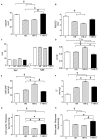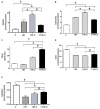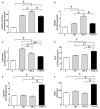Combined Aerobic and Resistance Exercise Training Improve Hypertension Associated With Menopause
- PMID: 30420811
- PMCID: PMC6215975
- DOI: 10.3389/fphys.2018.01471
Combined Aerobic and Resistance Exercise Training Improve Hypertension Associated With Menopause
Abstract
The prevalence of hypertension sharply increases in menopausal women. Recent studies have demonstrated that aerobic or resistance training may help control hypertension. In this study, we report that combining aerobic and resistance training may provide an effective therapeutic approach for hypertension control, attenuating inflammation and oxidative stress in ovariectomized rats. Female Wistar and spontaneous hypertensive rats (SHR) were distributed into four groups: sedentary control (C), sedentary hypertensive (HR), sedentary hypertensive ovariectomized (HR-O), and combined trained hypertensive ovariectomized (T-HR-O). Combined exercise training was performed on a motor treadmill (aerobic training) and on a ladder adapted to rats (resistance training), in alternate days for 8 weeks. Direct arterial pressure was recorded and oxidative stress and inflammation were evaluated in cardiac and renal tissue. Ovariectomy increases increased mean arterial blood pressure, sympathetic modulation, and oxidative stress in SHR. Combining aerobic and resistance training reduced mean arterial blood pressure (12% vs. HR-O), heart rate (8% vs. HR-O), vascular sympathetic modulation (40% vs. HR-O), and improved baroreflex sensitivity. Combined training reduced cardiac inflammation (TNF and IL-6) and cardiac and renal lipoperoxidation (59% and 57%, respectively vs. HR-O). It also enhanced cardiac (71%) and renal (76%) total antioxidant capacity when compared to HR-O group. In conclusion, combining aerobic and resistance training improves mean arterial blood pressure, cardiovascular autonomic control, preventing cardiac and renal oxidative stress and inflammation in an experimental hypertension model with surgical menopause induced with ovariectomy.
Keywords: cardiovascular autonomic dysfunction; combined exercise training; hypertension; inflammation; kidney; ovariectomy; oxidative stress.
Figures



Similar articles
-
Resistance or aerobic training decreases blood pressure and improves cardiovascular autonomic control and oxidative stress in hypertensive menopausal rats.J Appl Physiol (1985). 2016 Oct 1;121(4):1032-1038. doi: 10.1152/japplphysiol.00130.2016. Epub 2016 Jun 23. J Appl Physiol (1985). 2016. PMID: 27339182
-
Positive effect of combined exercise training in a model of metabolic syndrome and menopause: autonomic, inflammatory, and oxidative stress evaluations.Am J Physiol Regul Integr Comp Physiol. 2015 Dec 15;309(12):R1532-9. doi: 10.1152/ajpregu.00076.2015. Epub 2015 Sep 30. Am J Physiol Regul Integr Comp Physiol. 2015. PMID: 26423710
-
Aerobic or resistance training improves autonomic control of circulation in oophorectomized rats with cardiometabolic dysfunctions: Impact on renal oxidative stress.Exp Gerontol. 2021 Mar;145:111181. doi: 10.1016/j.exger.2020.111181. Epub 2020 Dec 16. Exp Gerontol. 2021. PMID: 33340684
-
A comparison of aerobic exercise and resistance training in patients with and without chronic kidney disease.Adv Chronic Kidney Dis. 2008 Jan;15(1):83-96. doi: 10.1053/j.ackd.2007.10.004. Adv Chronic Kidney Dis. 2008. PMID: 18155113 Review.
-
Effects of Different Kinds of Physical Activity on Vascular Function.J Clin Med. 2023 Dec 27;13(1):152. doi: 10.3390/jcm13010152. J Clin Med. 2023. PMID: 38202161 Free PMC article. Review.
Cited by
-
Food readjustment plus exercise training improves cardiovascular autonomic control and baroreflex sensitivity in high-fat diet-fed ovariectomized mice.Physiol Rep. 2023 Mar;11(5):e15609. doi: 10.14814/phy2.15609. Physiol Rep. 2023. PMID: 36898722 Free PMC article.
-
Activation of TRPV4 by lactate as a critical mediator of renal fibrosis in spontaneously hypertensive rats after moderate- and high-intensity exercise.Front Physiol. 2022 Sep 8;13:927078. doi: 10.3389/fphys.2022.927078. eCollection 2022. Front Physiol. 2022. PMID: 36160854 Free PMC article.
-
Characterization of the Oxidative Stress in Renal Ischemia/Reperfusion-Induced Cardiorenal Syndrome Type 3.Biomed Res Int. 2020 Oct 9;2020:1605358. doi: 10.1155/2020/1605358. eCollection 2020. Biomed Res Int. 2020. PMID: 33102574 Free PMC article.
-
Diabetes and hypertension: Pivotal involvement of purinergic signaling.Biomed Pharmacother. 2021 May;137:111273. doi: 10.1016/j.biopha.2021.111273. Epub 2021 Jan 30. Biomed Pharmacother. 2021. PMID: 33524787 Free PMC article. Review.
-
Combined Exercise Training Performed by Elderly Women Reduces Redox Indexes and Proinflammatory Cytokines Related to Atherogenesis.Oxid Med Cell Longev. 2019 Aug 5;2019:6469213. doi: 10.1155/2019/6469213. eCollection 2019. Oxid Med Cell Longev. 2019. PMID: 31482005 Free PMC article. Clinical Trial.
References
-
- Bernardes N., da Silva Dias D., Stoyell-Conti F. F., de Oliveira Brito-Monzani J., Malfitano C., Caldini E. G., et al. (2018). Baroreflex impairment precedes cardiometabolic dysfunction in an experimental model of metabolic syndrome: role of inflammation and oxidative stress. Sci. Rep. 8:8578. 10.1038/s41598-018-26816-4 - DOI - PMC - PubMed
-
- Bertagnolli M., Campos C., Schenkel P. C., de Oliveira V. L., De Angelis K., Bello-Klein A., et al. (2006). Baroreflex sensitivity improvement is associated with decreased oxidative stress in trained spontaneously hypertensive rat. J. Hypertens. 24 2437–2443. 10.1097/01.hjh.0000251905.08547.17 - DOI - PubMed
-
- Bjorkbacka H. (2006). Multiple roles of toll-like receptor signaling in atherosclerosis. Curr. Opin. Lipidol. 17 527–533. 10.1097/01.mol.0000245258.25387.ec - DOI - PubMed
-
- Bristow J. D., Gribbin B., Honour A. J., Pickering T. G., Sleight P. (1969). Diminished baroreflex sensitivity in high blood pressure and ageing man. J. Physiol. 202 45–46. - PubMed
LinkOut - more resources
Full Text Sources

